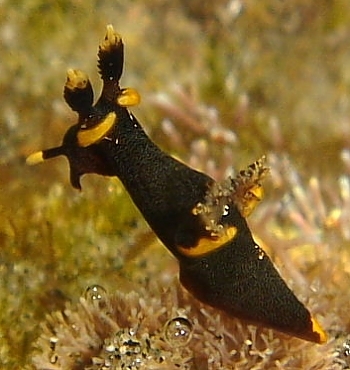
Trapania melaina
Gosliner & Fahey, 2008
Order: NUDIBRANCHIA
Suborder: DORIDINA
Superfamily: ANADORIDOIDEA
Family: Goniodorididae
DISTRIBUTION
Known only from the tropical Indian Ocean coast of South Africa.
PHOTO
Upper: Sodwana Bay, South Africa, Indian Ocean, Aug 2006, intertidal rock pools. Length: 12 mm. Photographer: Colin Ogden. Lower left: A35575. Radular morphology. Scale = 40 µm. [From Gosliner & Fahey, 2008: Fig 16C]. Lower right: A35575, South Africa, 8 mm. Photo: T. Gosliner.
The body is deep bluish black with a dusting of fine cream coloured spots. There are a line of white spots just behind each rhinophore and a yellowish patch surrounded by white spots just behind the gills. The tentacular anterior foot corners and the oral tentacles are black, but the oral tentacles are tipped with dull yellow or cream white. Similarly the rhinophores are black with a yellow or cream tip. The gills are translucent clear with yellow and black mottling. The extra-branchial and extra-rhinophoral processes are yellow with a solid black base, and there is a yellow streak at the posterior tip of the body/foot.
The living animal grows to at least 8 mm in length.
This species was previously known on the Forum as Trapania sp. 10.
-
Gosliner, T.M. & Fahey, S.H. (2008) Systematics of Trapania (Mollusca: Nudibranchia: Goniodorididae) with descriptions of 16 new species Systematics and Biodiversity, 6 (1): 53-98
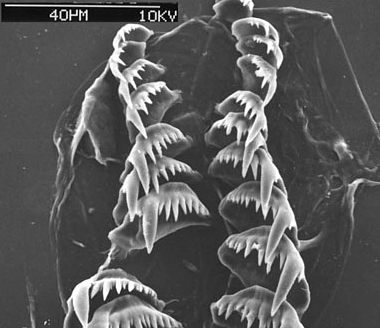
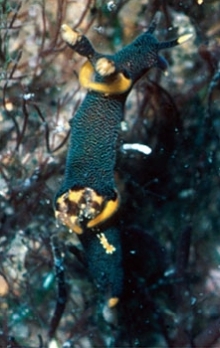
Rudman, W.B., 2008 (March 10) Trapania melaina Gosliner & Fahey, 2008. [In] Sea Slug Forum. Australian Museum, Sydney. Available from http://www.seaslugforum.net/find/trapmela
Related messages
Another photo of Trapania melaina
March 14, 2008
From: Colin Ogden
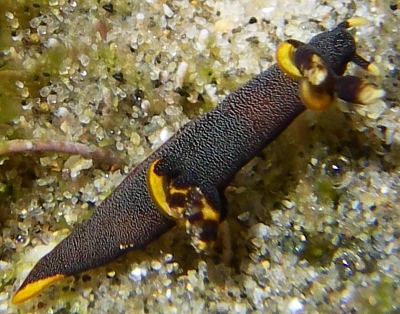
Hi Bill,
As I mentioned in an earlier message [#17671] here is a photo of the Trapania sp 2 in Gosliner's Nudibranchs of Southern Africa taken in a rock pool here at Sodwana by Jesse Feltmann.
Locality: Sodwana Bay, 1 metre, South Africa, Indian Ocean, Mar 2006, rock pool. Length: 8 mm. Photographer: Jesse Feltmann.
Regards
Colin
scubaco@iafrica.com
Ogden C. M., 2008 (Mar 14) Another photo of Trapania melaina. [Message in] Sea Slug Forum. Australian Museum, Sydney. Available from http://www.seaslugforum.net/find/16982Dear Colin,
This has been recently named Trapania melaina. It is good to get another photo, and record, of it.
Best wishes,
Bill Rudman
Gosliner's Trapania sp 2 from South Africa
September 6, 2006
From: Colin Ogden
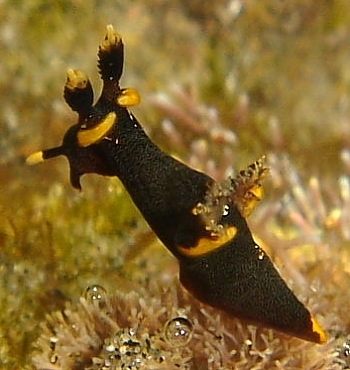
Note added 12 March 2008: This species has been named Trapania melaina.
Hi Bill,
The other day walking on our Jesser point I found this creature which I think is the same as Gosliner's Trapania sp. 2 on page 94 of his Nudibranchs of Southern Africa. I see his photo was taken at the same place. I have never seen it on a dive, so could it be restricted to rock pools. It also seems quite common at the moment as a friend Jesse Veldmann also has photos of it. Could it be a seasonal find (winter months only), and also can some slugs be restricted to seasons as well.
Locality: Sodwana Bay, 0 metres, South Africa, Indian, Aug 2006, Rock Pools. Length: 12mm. Photographer: Colin Ogden.
Regards
Colin
scubaco@iafrica.com
Ogden C. M., 2006 (Sep 6) Gosliner's Trapania sp 2 from South Africa. [Message in] Sea Slug Forum. Australian Museum, Sydney. Available from http://www.seaslugforum.net/find/17671Dear Colin,
This certainly appears to be Gosliner's species. I note he had only a single specimen. From his photo the body is covered in fine white specks. I am pretty sure it is unnamed so I will add to the Forum list asTrapania sp. 10 .
Concerning your question about animals being seasonal. I would say there are very few opisthobranchs that do not follow some cyclic appearance. In most it would be seasonal, and influenced by water temperature, salinity, water currents and other physical parameters. All these species are very dependent on their food so cycles are also affected by the presence and absence of their food organisms. In tropical places where it seems warm all year, cycles are still very pronounced.
Best wishes,
Bill Rudman
